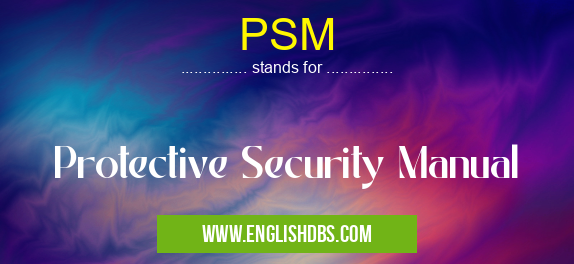What does PSM mean in CYBER & SECURITY
PSM stands for Protective Security Manual, and it is used in computing and information security contexts. The manual outlines the policies, procedures, and processes designed to protect a company’s network from malicious activities or threats. It also provides guidance on how to respond to security incidents and strengthen an organization’s security posture. In many cases, the PSM is accompanied by technical controls such as antivirus software, firewalls, intrusion detection systems, and other security mechanisms.

PSM meaning in Cyber & Security in Computing
PSM mostly used in an acronym Cyber & Security in Category Computing that means Protective Security Manual
Shorthand: PSM,
Full Form: Protective Security Manual
For more information of "Protective Security Manual", see the section below.
Essential Questions and Answers on Protective Security Manual in "COMPUTING»SECURITY"
What is the purpose of Protective Security Manual?
The Protective Security Manual (PSM) provides guidance to government agencies and their employees, contractors, and service providers on how to protect an organization’s assets, information, people, processes and services from a range of threats.
Who is responsible for implementing PSM?
The responsibility for implementing PSM rests with the Heads of Agency or equivalent responsible for overall security in the organization. They have ultimate responsibility for identifying risks; selecting appropriate protective measures; providing resources to implement them; reviewing and monitoring the effectiveness of the protective measures taken and reviewing document control.
What types of threats does PSM protect against?
PSM protects against a range of threats including espionage, sabotage attack, theft or misuse of sensitive information, political or economic interference or malicious damage to property or life. It also addresses risks such as natural disasters or accidents that could adversely affect critical operations.
What are some key principles addressed in PSM?
Key principles covered in PSM include Risk Management; Designated Responsibility; Document Control; Training and Awareness; System Specifications; Physical Security Measures; Personnel Security Measures; Information System Surveillance; Intrusion Detection Systems; Fraud & Corruption Prevention Measures; Insider Threats; Access Control Systems and Breach Response Planning.
Does PSM cover both physical security measures and personnel security measures?
Yes. In addition to physical security measures such as guards, fencing systems, access control systems, CCTV etc., PSM also covers personnel security measures such as background checks on staff members who have access to sensitive information, visitor logging systems etc..
Is there any particular format which needs to be followed while preparing a Protective Security Manual?
Yes. A good way to prepare a Protective Security Manual is by completing a Threat Assessment where all the potential risks are identified before any relevant protective measures are decided upon. To ensure that different sections are covered clearly it can be helpful to break up policies into core areas such as Document Controls, Personnel Security Measures, Physical Protection Solutions etc.. Each section should then provide clear guidance on roles/responsibilities within the organization as well as policies & procedures which must be adhered to ensure effective protection.
Are there different levels of threat identified under PSM?
Yes. Threats can be placed into three categories within your Protective Security Manual – Low Risk – Any threat that has minimal/no impact but may require further review by senior management should it increase in severity over time Medium Risk – Any threat which can potentially cause major disruption but not create great levels of harm High Risk –Any threat that could significantly disrupt operations or result in major financial loss OR grievous bodily harm/ death
Are revisions necessary when changes occur within an organization's functions or activities?
Yes. It is important that when changes occur within an organization that relevant updates are made in accordance with legislation/regulatory requirements and best practice guidelines related to personal and physical safety standards outlined within your organizations Protective Security Manual.
Final Words:
The Protective Security Manual (PSM) is an important tool for helping organizations defend against cyber threats while meeting industry compliance requirements. The manual outlines the policies, procedures, processes and guidelines needed for maintaining adequate network security from malicious actors or attacks from outside sources like phishing campaigns or malware infections. By clearly defining what needs to be done during different phases of the response process — remediation of vulnerabilities before they are exploited; incident detection when suspicious activity has been identified; investigation into cause of breach; rectifying issues found during investigation — the manual aids in strengthening an organization’s overall security posture against external threat actors.
PSM also stands for: |
|
| All stands for PSM |
